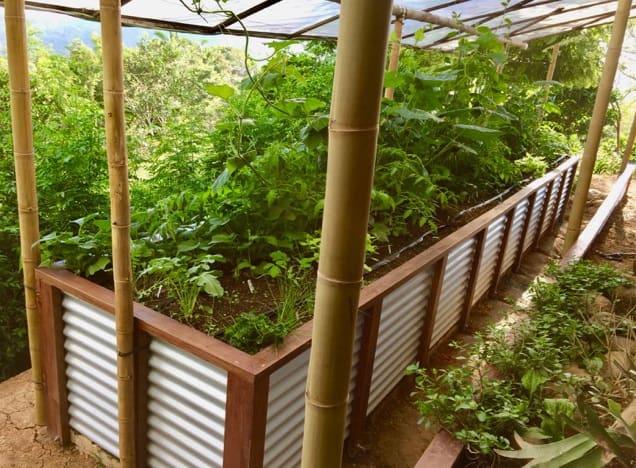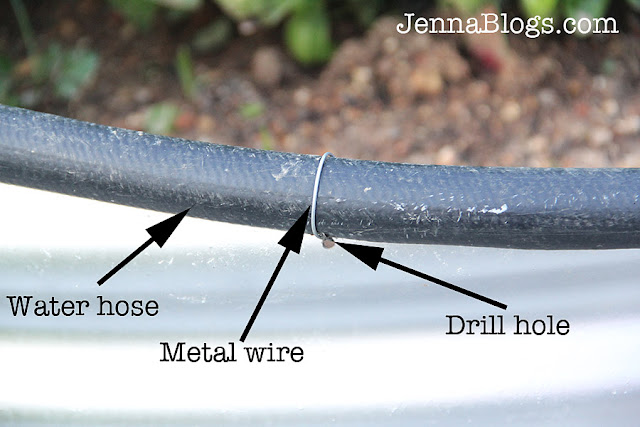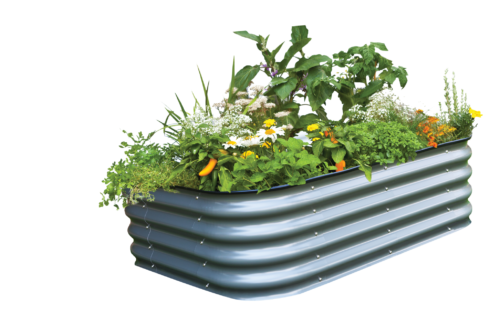Hügelkultur: Why You Should Build This Ultimate Raised Bed
June 19, 2018 by Lydia Noyes
This post may contain affiliate links. Read our Affiliate Disclosure here.
Erick Rifkin's raised bed design, based on the concept of hügelkultur. ((Courtesy of Ed Bernhardt and Erick Rifkin)
Hügelkultur: Why You Should Build This Ultimate Raised Bed
Are you looking for a gardening strategy that reduces your water requirements, provides long-term soil fertility, and is a self-sustaining system once you set it up? If so, it’s time to learn more about hügelkultur, a traditional German gardening solution that relies on wood piles to grow healthier plants.
Whether you’ve got a green thumb already or can barely keep a potted plant alive, hügelkultur has a lot to offer your backyard garden – if you are willing to take the time to set it up. Thankfully, the process is easier than you think.
What is Hügelkultur?
Roughly translating to “mound culture” in German, hügelkultur is a centuries-old gardening technique where logs are used as the base material for building mounded planting beds. The Austrian permaculture expert Sepp Holzer first popularized the process as a way to construct self-fertilizing garden systems that increase the available growing space while minimizing its fertilizer and irrigation needs.
This method is used predominately in permaculture systems, as it mimics the natural nutrient cycling process within a forest. Just as a forest floor builds up its fertility over time through layers of decomposing logs and detritus, hügelkultur beds are designed to be self-sustaining and regenerative for years, even decades after they are installed.
How Hügelkultur Works
They might look complicated, but hügelkultur beds are little more than massive compost piles built from decaying wood debris and other biomass. As fungi and bacteria break down this material over time, the logs and branches are transformed into a sponge-like growing medium that’s filled with air pockets which support consistent moisture levels and encourage robust root growth.
While hügelkultur is ideal in places with poor quality soil, soil compaction, or limited water resources, the beds can be used in any growing condition. While the mounds themselves might vary slightly depending on what’s available, the general idea is that the garden beds are built with large chunks of wood at the base, including tree trunks, branches, and brush. Compost and topsoil are then mounded overtop, creating a productive growing space for both annuals and perennials.
Benefits of Hugelkultur
Why should you go through the bother of setting up hügelkultur beds? In short, the services that they offer your vegetable garden are hard to pass up. Some of the benefits of hügelkultur beds include:
Retain moisture (even without irrigation) for weeks or months at a time
Sloped sides maximize planting space
Create natural air pockets for plant roots
Constant supply of organic material for plants
Self-tilling (soil shifts as the logs decompose)
Warms the soil through the natural composting process
Prevents excess nutrients from leaking into groundwater
Can produce fertile growing conditions without added fertilizer for over twenty years
Sequesters carbon into the soil to reduce greenhouse gasses
Ideal for desert conditions
Puts plant material to use that otherwise would be wasted
Easy to expand over time
Little weeding is usually necessary
Mounded beds make harvesting easier
How to Get Started with Hügelkultur
Convinced by the benefits of hügelkultur yet? Building a bed is easier than you think. Just follow these step-by-step instructions to get started.
1. Select Your Bed Site
When it comes to hügelkultur, one size does NOT fit all. Some people prefer to make huge hügelkultur beds that maximize the planting space, though it’s best to start small (6 feet by 3 feet is popular) for your first bed to ensure you have enough plant material to make it work.
Where you put your bed is just as important as its overall size. Some hugel beds are built east-west to take maximum advantage of microclimates over the course of the day, though a north-south orientation tends to allow for more light exposure for vegetable production.
When selecting a site, pay attention to water flow in the garden to see where water pools and drains. A hugel bed’s sponge-like nature can make them perfect for soaking up access water in naturally moist regions, but too much water will compromise the bed’s overall structure.
Another factor is whether you want to “bury” your bed. Some gardeners prefer to dig a trench to give their logs a better start at decomposing and reduce the overall height of the bed. However, this adds more effort to the construction process for relatively little benefit.
Finally, hugel beds will affect your yard’s airflow, so take into consideration the direction that dominate winds come from and whether any parts of your garden will benefit from a wind block. Likewise, any crops planted at the top will need to survive significant wind exposure, so orient the bed accordingly.
2. Gather Necessary Materials
Quality hugel beds require a stable foundation, so plan to collect as much woody material as possible before beginning. The “foundational” layer of the bed can be built with uncut logs, thick branches, untreated scrap lumber, and even whole trees.
Hardwoods are most suitable because they break down slowly and help the bed last longer and retain higher nutrient levels. Softwoods can also work, but they break down faster and will give you fewer seasons for planting. To maximize the benefits for your garden, start with a hardwood base and layer softwoods on top so that the bed includes a quick source of fertility that won’t deplete itself.
Best hügelkultur wood types: apple, aspen, maple, oak, poplar, birch, cottonwood.
Mediocre hügelkultur wood: cedar, juniper, (rotted) black cherry, eucalyptus, pine, red mulberry.
Worst hügelkultur wood: black locust, old growth redwood, black walnut.
Of note: all treated wood, including railroad ties, construction lumber, pallets, and anything painted or stained should be avoided.
Beyond wood, it’s also essential to acquire different sources of nitrogen-rich material for layering in the bed (manure or kitchen scraps work well), a straw mulch, and enough topsoil to cover it to a depth of 1 to 2 inches. Wood chips can be used in the middle layers, though they decompose quickly and don’t offer long-term fertility.
3. Place the Bottom Logs
You’re ready to begin building your bed once the log type and location have been determined. First, lay the largest logs down as a first layer in the bed. The trunks should be placed tight together to ensure the foundation keeps its shape as you stack layers on top.
4. Add Additional Layers
Next, add layers of thick branches to the logs, adding the material according to size so that the largest branches are on the bottom. You can then begin filling in the gaps with smaller branches to make it stable. Between layers of wood, incorporate several inches of “green” material like compost, kitchen scraps, manure, or grass clippings. This balances the nitrogen levels in the bed to better optimize it for vegetable production.
The wood-to-soil ratio depends on how fresh your wood is. Freshly cut timber requires more top dressing, while already-decomposing logs need less.
5. Water Layers in Well
Water down the layers as you build up your bed to jump start the decomposition process. To make things simpler, it’s also possible to let the logs set through several rainstorms before you build up the final layers of finer material.
6. Create Steeply Sloped Sides
While hugel beds can look any number of ways, steeper sides (close to 45 degrees) provide extra benefits like microclimates, warmer soil, better oxygenation, and less compaction over time. Nonetheless, you can form your bed into any shape you prefer, from gentle arcs to flat rectangles. Generally, beds that are several feet tall tend to work best over the long run.
7. Finish it Off with Top Soil
Once the bones of your hugel bed are in place, top it off with 1-2 inches of topsoil and a thick layer of mulch. The bed is complete!
8. Prepare for Planting
Though it’s possible to plant in hugel beds right away, most will benefit from “curing” for several months before you add your seedlings. Consider building a bed in the fall and letting it set throughout the winter before first planting it in the spring. When the time comes, you can plant seeds or transplants into the bed as you would any other garden bed, taking into consideration that the plants on the top have the most significant exposure to the elements.
9. Maintain the Bed Over Time
The beauty of hügelkultur is that well-prepared beds take little maintenance work beyond basic cosmetics. As the logs within the bed begin to break down, the structure might start to slump or sink down. Refrain from tilling or turning the bed, but rather top dress it with additional compost to retain their size and ensure the microorganism habitats stay robust.
Some people start with small beds and slowly build them up each year. You can aim for two and a half feet tall the first year and add approximately a foot each subsequent year to keep the size slowly growing as you offset its natural sinking.
Is Hügelkultur Right for You?
While hügelkultur is a stellar agricultural solution across the globe, it’s not right for every situation. You might want to reconsider investing your time setting up a hugel bed if any of the following circumstances sound like you.
You are part of a homeowners’ association with strict landscaping rules that prevent you from building mounds. Note: a submerged hugel bed might be a smart workaround.
You lack access to the large amounts of wood needed for building a bed.
You don’t want a permanent bed in your yard or prefer to start the garden fresh each spring.
You can’t commit to the manual labor needed to build it. While hugel beds are less work in the long run, they take significant effort to get established.
You have an exceptionally moist climate. Too much rainfall can make hugel beds perpetually wet and attract slugs, molds, and fungal diseases to your plants.
You aren’t comfortable with wildlife. Small critters like chipmunks and snakes often like to make hugel beds their home. While this is beneficial for your garden’s pest populations, some people find them to be a deterrent.
Regardless of whether you decide to set up a hügelkultur system in your garden, taking time to grow plants more sustainably is a benefit for both your health and the environment. For more advice on ways to make your garden amazing, check out these articles on how to set up a square foot garden system and ways to save money in your garden this year.
https://www.naturallivingideas.com/hugelkultur/


























